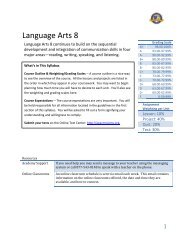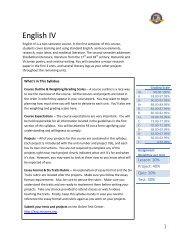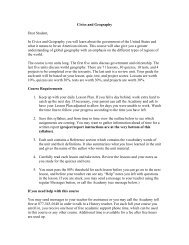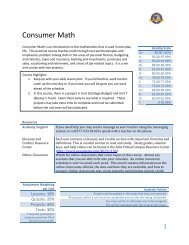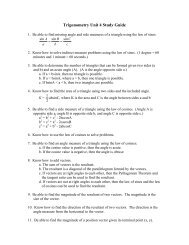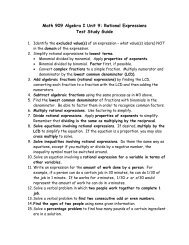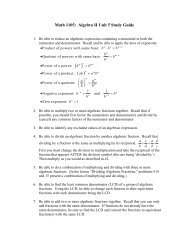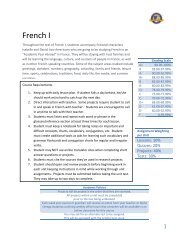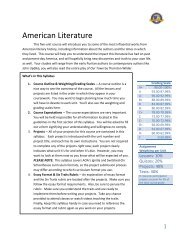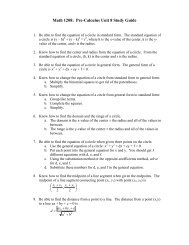English III - Alpha Omega Academy
English III - Alpha Omega Academy
English III - Alpha Omega Academy
- No tags were found...
Create successful ePaper yourself
Turn your PDF publications into a flip-book with our unique Google optimized e-Paper software.
<strong>English</strong> <strong>III</strong><strong>English</strong> <strong>III</strong> is a two-semester course and is the precursor to <strong>English</strong> IV. In the first semester of thiscourse, students cover learning and using standard <strong>English</strong>, sentence elements, meaning, main ideas,and poetry. Students are also introduced to the research process while writing a biographical article.The second semester entails elements of nonfiction, American drama, the American novel, research,and cumulative review unit. Larger works read in this course are The Old Man and the Sea and OurTown. In Unit 9 there is a research project that must be completed satisfactorily to receive credit forthe second semester.What’s in This SyllabusCourse Outline & Weighting/Grading Scales -- A course outline is a nice wayto see the overview of the course. All the lessons and projects are listed inthe order in which they appear in your coursework. You may want to beginplanning how much time you will have to devote to each unit. You’ll also seethe weighting and grading scales here.Course Expectations -- The course expectations are very important. You willbe held responsible for all information located in the guidelines in the firstsection of this syllabus. You will be asked to fill out a form signifying yourunderstanding and willingness to comply.Projects -- All of your projects for this course are contained in this syllabus.Each project is introduced with the unit number and project title, and eachhas its own instructions. You are not required to complete any of theprojects right now; each project clearly indicates what unit it’s for and whenit’s due. However, you may want to look at them now so you know what willbe expected of you.Essay Format & Six Traits Rubric -- An explanation of essay format and the SixTraits rubric are located after the projects. Make sure you follow the essayformat requirements. Also, be sure to peruse the rubric. Make sure youunderstand the traits and are ready to implement them before writing yourprojects. Take any chance provided to attend classes or watch videosteaching the traits. Finally, keep this syllabus handy in case you need toreference the essay format and rubric again as you work on your projects.Grading ScaleA+ 98.00-100%A 93.00-97.99%A- 90.00-92.99%B+ 88.00-89.99%B 83.00-87.99%B- 80.00-82.99%C+ 78.00-79.99%C 73.00-77.99%C- 70.00-72.99%D+ 68.00-69.99%D 63.00-67.99%D- 60.00-62.99%F 0-59.99%AssignmentWeighting per UnitProjects: 40%Tests: 30%Quizzes: 20%Lessons: 10%If required, participationprojects account for 5%of the total course grade.1
Resources<strong>Academy</strong> SupportOnline ClassroomsIf you need help you may send a message to your teacher using the messagingsystem or call 877-543-0148 to speak with a teacher on the phone.An online classroom schedule is sent via email each week. This email containsinformation on the online classrooms offered, the date and time they areavailable, and how to connect. Online classrooms may count towardsparticipation project credit.Course OutlineUnit 1: Learning and Using Standard <strong>English</strong>Assignments1. Project: Language Arts Course Expectations 11. Technical Texts2. Acquiring a Language 12. Informational Texts3. Learning a Standard 13. Literary Texts4. Levels of Usage 14. Quiz 3: Varieties of Written Standard <strong>English</strong>5. Essay: Levels of Standard <strong>English</strong> 15. Documentation6. Quiz 1: Why Standard <strong>English</strong>? 16. Works Cited7. Making a Dictionary 17. Parenthetical Citations8. Anatomy of a Dictionary 18. Documentation Review9. Quiz 2: Dictionaries: Guardians of the Standard 19. Test: Learning and Using Standard <strong>English</strong>10. Types of Written Standard <strong>English</strong>Unit 2: Sentence ElementsAssignments1. Biographical Article Project: Preparation 7. Verbals: Participles2. Clauses 8. Verbals: Infinitives3. Adverb Clauses and Adjective Clauses 9. Combining Verbals4. Noun Clauses 10. Appositives5. Quiz 1: Clauses 11. Quiz 2: Verbals and Appositives6. Verbals: Gerunds 12. Test: Sentence ElementsUnit 3: Clear Connections: A Writing WorkshopAssignments1. Biographical Article Project: Rough Draft 8. Pronoun Reference2. Nouns and Pronouns 9. Pronoun Agreement3. Jobs Personal Pronouns Do 10. Quiz 2: Using Pronouns4. Other Types of Pronouns 11. Using Modifiers Correctly2
5. Quiz 1: Understanding Pronouns 12. Using Parallel Structure6. Pronoun Case (Part 1) 13. Quiz 3: Writing Strong Sentences7. Pronoun Case (Part 2) 14. Test: Clear Connections: A Writing WorkshopUnit 4: Meaning and Main IdeasAssignments1. Biographical Article Project: Consultation 9. Diacritical Marking2. Biographical Article Project: Rough Draft 10. Quiz 2: Word Meanings and Pronunciation3. Greek Prefixes 11.Finding the Main Idea4. Latin Prefixes 12. Quiz 3: Main Ideas5. Greek Roots 13. Analyzing a Textbook6. Latin Roots 14. Quiz 4: Analyzing a Textbook7. Quiz 1: Prefixes and Roots 15.Test: Meaning and Main Ideas8. Context CluesUnit 5: PoetryAssignments1. Project: Explore Poetry 9. The Experience of Faith (cont.)2. Measurement in Poetry 10. The Experience of Love3. Meter and Metrical Sets 11. Project: Society and Young People4. Musical Effects: Rhyme 12. Quiz 2: Poetic Themes5. Other Musical Effects 13. Imagery and Connotation6. Form in Poetry 14. Essay: Writing a Poem7. Quiz 1: Structure of Poetry 15. Quiz 3: Imagery and Connotation8. Universality and the Experience of Faith 16. Test: PoetryUnit 6: NonfictionAssignments1. Elements of Nonfiction 8. Periodicals2. Exposition 9. Quiz 2: Types of Nonfiction3. Description 10. Nonfiction Topics for Reading4. Quiz 1: Elements of Nonfiction 11. Other Nonfiction Topics for Reading5. Essays and Sermons 12. Approaches to Nonfiction6. Diaries, Journals, and Letters 13. Quiz 3: Nonfiction Topics7. Biography and Autobiography 14. Test: NonfictionUnit 7: American DramaAssignments1. The Development of Drama 7. Wilder’s Our Town2. Drama in America 8. Our Town: Act I3. Quiz 1: The Development of Drama 9. Our Town: Act II4. The Art of Drama 10. Our Town: Act <strong>III</strong>3
5. The Structure and Reading of a Play 11. Quiz 3: Our Town6. Quiz 2: The Art of Drama 12. Test: American DramaUnit 8: Studies in the American NovelAssignments1. Essay: Character Description 10. To Kill a Mockingbird—12-152. The American Novel 11. To Kill a Mockingbird—16-193. Cooper and Hawthorne 12. To Kill a Mockingbird—20-254. Nineteenth Century Novelists 13. To Kill a Mockingbird—26-315. Twentieth Century Novelists 14. The Critical Essay6. Quiz 1: Survey of American Novels 15. Writing the Critical Essay7. To Kill a Mockingbird--Introduction 16. Quiz 3: To Kill a Mockingbird8. To Kill a Mockingbird—6-11 17. Test: Studies in the American Novel9. Quiz 2: To Kill a MockingbirdUnit 9:ResearchAssignments1. Research Paper Project: Prewriting 9. Quiz 2: Gathering Information2. The Investigative Process 10. Keeping it Relevant3. Choosing Your Subject 11. Revised Thesis4. Quiz 1: The Investigative Process 12. Outlining the Paper5. Locating Sources and Taking Notes 13. Using Sources and Trasitions6. Using Note Cards 14. Writing and Revising7. Formulating a Thesis 15. Quiz 3: The Composition8. Thesis Statement 16. Test: ResearchUnit 10: ReviewAssignments1. Research Paper Project: Essay 11. Critical Analysis2. Context Clues and Word Parts 12. Quiz 3: Expository Prose3. Dictionary Skills 13. American Drama4. Quiz 1: Analyzing Written Words 14. Elements of Poetry5. Clauses and Sentence Types 15. American Poetry6. Phrases 16. Early American Novels7. Avoiding Sentence Errors 17. 20 th Century Novels8. Quiz 2: Writing Effective Sentences 18. Nonfiction9. Writing Expository Prose 19. Quiz 4: American Literature10. Research Papers 20. Test: Review4
<strong>English</strong> <strong>III</strong> Course ExpectationsPlease read this agreement with your supervising adult. Thank you! We’re looking forward toworking with you this year!Before you begin this course, make sure that you bookmark the student resources page, here:http://www.aoacademy.com/kb/?c=88. This will be a great reference source for you as you work,so make sure to refer back to it often.The information in this agreement is for your student’s benefit and guidance as he/she works through his/her<strong>English</strong> class. Your student will be held accountable to remember and adhere to these policies; returning thecompleted form found in your coursework indicates that the information has been understood and that thesupervising adult and student intend and agree to comply with the policies. Adhering to these policies will help thestudent be successful in his/her learning goals.Daily Lessons Please take a moment to read Studying Techniques on the AOA resource center.As Studying Techniques indicates, it will be extremely beneficial for you to take notes as youread and study your daily lessons. Read your lessons carefully before attempting to answer thelesson questions. The lesson questions are for your benefit – so you can be sure you haveunderstood the concepts and ideas in the lesson. If you find yourself “hunting” for too manyanswers you may not have comprehended the lesson sufficiently; go back and study the ideasand concepts in your lesson more before proceeding with the questions.Do EVERYTHING in the lesson. This includes playing games, watching videos, listening to theaudio files, and, most importantly, clicking on the links provided. Several of your lessons cannotbe completed if you do not click on these links, so be sure to watch for them.When you get a lesson question wrong, pay close attention to that question. Having the chanceto answer it again gives you a chance to LEARN that concept more fully. Don’t just go searchingfor the right answer. It’s important to understand the concept behind the question. It’s not atall uncommon for quizzes and tests to contain material that is similar to daily lesson questions.By ignoring “missed questions” on lessons, you may be setting yourself up to miss any similarquestions on quizzes and tests.Be aware that you may not always be able to find an answer word for word in the text. As youenter into higher level courses, it is expected that you will take your understanding and applyyour knowledge to various situations. You will need to make connections based on what youhave learned, not simply hunt for answers in the text.All lesson questions must be completed. Lesson questions show your comprehension andunderstanding of the concepts in the lesson. This is especially true of questions which require asentence or paragraph answer.Answer in complete sentences with proper punctuation, grammar, and spelling. Points will bededucted for spelling or grammatical mistakes.5
Copying material from the lessons into the lesson answer boxes is not appropriate. Students arerequired to phrase answers in their own words.Copying material from outside webistes is a violation of AOA’s Academic Integrity policy, anddoing so will result in serious consequences.Understand that you might be tested over anything in a lesson.A list of vocabulary terms and definitions will be available at the beginning of each lesson, so useit as a study tool.If you are running stuck on grammar concepts, try one or more of the sites listed on a documentcontaining many Writing and Grammar Tools found on the resource center:http://www.aoacademy.com/kb/?a=379Self tests/quizzes and tests: Self tests/quizzes and tests are closed book; no study materials, notes, or any other informationare allowed during the assessment.Think about a student taking a quiz or test in a brick and mortar school building. Once a studentsits down to take a quiz or test, he/she is not allowed to move until after handing in that quiz ortest. In the same way, you need to be serious and conscientious about your time andsurroundings when you take a quiz or test for your AOA schoolwork.o Do not open tests until you are ready and have studied thoroughly.o Do not open a test if you do not have sufficient time to dedicate to finishing it. Testsshould be taken in one sitting; do not exit the test or leave it before finishing it. If youleave the test open for too long, it will automatically close, and it will be graded as is.You will not be able to finish your test or change any answers.Self tests/quizzes- Self tests and quizzes are comprehensive; the student may be tested on any materialcovered thus far in that unit.Tests- Tests may cover everything in your unit. You will have only once chance to complete a test,so be sure you are prepared before taking it.- Alternate tests may be taken if you desire. Please contact the <strong>Academy</strong> if you would like totake an alternate test. (The two test scores will be averaged together.)Projects: Project expectations: Essays and assignments must be the student’s original creations,generated single-handedly by the student. Work may not have been submitted previously for agrade at <strong>Alpha</strong> <strong>Omega</strong> <strong>Academy</strong>, or any other school. No plagiarized, incoherent, incomplete, ordistasteful assignment will be accepted. Similarly, assignments may not mention, or refer to, anyoffensive, violent, illegal, disparaging or inappropriate language (including, but not limited to,words that are widely considered offensive to individuals of a certain race, ethnicity, or religion);6
promote the abuse of alcohol, illegal drugs, or tobacco ; or promote any activities that mayappear unsafe or dangerous.Assignments that violate these expectations may be reassigned to the student with a 20% gradededuction. Plagiarized work will be handled according to the <strong>Alpha</strong> <strong>Omega</strong> <strong>Academy</strong> plagiarismpolicy.Projects may be reassigned to the student for any of the following reasons:- The instructions were not followed completely.- MLA documentation is missing or incorrect.- The teacher requested changes be made to the project, and the student resubmittedthe work without making the requested changes.- Some projects will be part of a multi-step process (For example – writing a thesisstatement and an outline for a five paragraph essay, finding your sources for a researchpaper, etc.). Projects which are part of a multiple-step process should be submitted oneat a time and in the given order. Not being submitted as such may result in a gradededuction.If a project has been reassigned for any of the above reasons, it may receive a 20% gradededuction.Projects are 40% of your unit grade; it is very important to do your best on them.Projects are not optional. Every project must be completed to the satisfaction of the teacher.The formatting of your projects is important and it counts toward your grade. Projects must besubmitted with heading information – which includes your name, the date, your teacher’s name,and the class in the upper left corner of the first page of your assignment. See below for moreinformation on how to format your projects.When you first start each unit, read through all the directions for any projects in that unit sothat you will be prepared to complete them.Projects are not meant to be completed in a matter of minutes. Work on them as you workthrough your unit, being careful to follow all directions.Written projects may take longer to grade than lessons or tests. Be assured that your teacherswill grade your work as soon as possible. Projects will be graded in the order in which they arereceived.After your project has been graded, go back to the file you uploaded to look for your teacher’sfeedback. This feedback is very important for improving your writing skills and doing better onyour next project. If you do not know how to access the graded file, please call the language artsdepartment.Academic Support: You can find your teacher’s schedule for when they are available in their online office hoursusing the Gradebook on your DashboardStudents are encouraged to get academic support by contacting their teachers when they needassistance on their lessons. This is the best way to complete your participation projects.7
Be specific in your correspondence and communication with your teacher. (“I need help” is notspecific.) The better your teacher understands your problem, the quicker he or she will be ableto help you.Be polite and scholarly in your correspondence and communication with your teacher. Useproper spelling, grammar, and punctuation in all of your academic dealings with your teachers.Texting abbreviations or spellings are not acceptable or appropriate.Any message or email that you send to your teacher is expected to have a greeting (“Dear Mr. orMs. [Teacher’s last name]”) and signed with your name.Teachers cannot help students during tests and quizzes, although they can clarify what aquestion is asking if you are confused.<strong>English</strong> <strong>III</strong> Projects*******1101 ESSAY: LEVELS OF STANDARD ENGLISHIn this project, you will have an opportunity to use colloquial, informal, and formal Standard<strong>English</strong> by adjusting your language to situation and audience.Here is your goal for this assignment:Determine appropriate language usage based on real-life scenarios.Select one of the options below for a writing assignment in which you adjust the kind ofStandard <strong>English</strong> you use to audience and situation.Option A: Think of a problem in your community, city, or state (traffic, pollution, crime,graffiti, homelessness, poverty, etc.). Write three people, adjusting your language appropriatelyfor each audience.1. Write a note (or e-mail) to a friend telling him about the problem and what you thinkshould be done about it.2. Next, write your teacher or pastor on the same topic.3. Finally, prepare a formal letter to send to your senator.8
Option B: Think of a realistic scenario in which you have discussed a problem at school withfriends. Maybe the sports equipment is worn out or lunch break is too short because of the busyschedule. Write a plan for three conversations, adjusting your language appropriately.1. Write out what you would say to your friends about the problem, using colloquiallanguage.2. Next, imagine talking to your parent(s) about the same problem. Write out what youwould say.3. Now, write out what you would say to the principal.4. Finally, imagine that the principal is convinced and schedules you to speak at the nextschool board meeting. Write out your speech (no more than one-half page).NOTE: Option B may not be applicable to all students. If Option B is not applicable, you willneed to choose Option A.Your essay will be graded based on the following:your attention to the instructions given aboveword count as stated in the directionsuse of proper punctuation, spelling, grammar, and sentence construction (commonlycalled "conventions")proper paragraphing (either indent each paragraph five spaces OR double-space betweenparagraphs)1102 Biographical Article Project: PreparationThis project is meant to prepare you to reach your goal of writing a brief (700 word) biographicalarticle about an acclaimed American author. The final project will be due in your next unit. Tohelp your writing go smoothly, you will spend time this unit brainstorming a topic, crafting athesis statement, and creating an outline for you paper.Here are your goals for this project:Brainstorm to determine the author you want to write your essay on.Create several thesis statements for your research essay and choose one that youwould like to use.Develop an outline for your essay.Part One: Brainstorming9
1. Make a list of notable American books, stories, and/or poetry. If possible, choosematerial that you have actually read.Behind each book, story, or poem, write the type of literature and the author’s name. Dosome research to find out the background of this author, if he/she is considered anacclaimed author, or other pertinent information. Share some of the information youdiscovered, along with the sources you used.For this project you will need to have 5 to 10 books or poems with authors, information, andsources recorded. Each entry should have at least 2 pieces of information from 2 differentsources. A sample entry follows.“Dreams,” poem by Langston HughesHis writing was considered very influential in the Harlem Renaissance of the 1920s.from POETS.orgHughes was the first African American author able to make a living by writing. fromhttp://www.csustan.edu/english/reuben/pal/chap9/hughes.htmlMany of his contemporaries did not like the way he portrayed black life: they said it wastoo unattractive. from poetryfoundation.orgNotice that the websites used are reputable, reliable sources. Wikipedia was not used, eventhough that was the first result when searching for information about Langston Hughes.2. After you have done this for a few authors, select one to write your essay about. Then,write a paragraph telling which author you have chosen to write about and why. Yourparagraph must have at least 5 sentences, and could explore the availability of resources,your interest in the author, and his renown, among other topics. An example follows.I have chosen to write about Langston Hughes. “Dreams” is one of my favorite poemsbecause of its deep meaning but simple style. I also was able to discover many sources ofinformation while looking into researching Hughes. It is really interesting to me thatmany of his contemporaries were unimpressed with his work or questioned theappropriateness of writing about the black experience with honesty. It will be interestingto find out more about their perspective, as well as his view of the criticism. I am alsolooking forward to getting to know more of his work.Part Two: ThesisComplete part one before starting part two.Now is the time to really get into doing your research for this assignment. You will need to knowa good deal about your author before you formulate a comprehensive thesis statement.10
As you research, make sure that you record the information carefully and include theinformation about your sources.Step 1: Begin to experiment with creating a thesis statement.Think about these questions as you formulate thesis statements: What are the really importantthings that you want to say about this author? How will your essay differ from the others aboutthis author? Why do people need to know about this author? Why should your readers careabout this writer?Remember, a strong thesis statement is a specific thesis statement. The better you can defineyour goal for your paper, the better your thesis statement, and, consequently, your paper, will be.A thesis statement is not a question or a fact. Rather, it is a one-sentence summary of the mainidea you want to explain or prove in your paper.You will be writing at least 4 different potential thesis statements. Experiment with differentsentence types as you create your possible thesis statements. Here are some examples of whatyou will do.Langston Hughes became the star of the Harlem Renaissance by drawing on events in hislife to write about the black experience in America.Although Langston Hughes had critics among his contemporaries, he became the star ofthe Harlem Renaissance by drawing on events in his life to write about the blackexperience in America.Langston Hughes was able to rise above the criticism of his peers, and he eventuallybecame the star of the Harlem Renaissance.Langston Hughes, who is considered the star of the Harlem Renaissance , wrote muchacclaimed literature, yet he had critics among his contemporaries.Step 2: Choose one thesis statement that you would like to use, and either bold or underline it.Take note of how that was done in the statements above.Step 3: Below your thesis statement, write a cohesive paragraph explaining why your thesisstatement meets the requirements listed in the resources above. If your thesis statement is notacceptable or your paragraph does not meet the requirements, the project will bereassigned. An example paragraph follows:I feel that this thesis statement expresses all the main points that I want to cover. I want to showhow Hughes was the strongest black American voice during his time period, how he depicted theblack experience as it really was, and how many other black writers of that time did notappreciate his work. This sentence is a good compass for where I will go with my essay.11
Part Three: OutliningComplete parts 1 and 2 before starting part 3. As you take notes, be sure to include the locationof each source (see MLA guidelines).Develop a sentence outline for the information that you have found. Remember that your outlinemust be in standard format.Outline Construction Instructions:Construct your outline for your research project. Be sure to include your thesisstatement in the outline. Remember that the more detail you have in your outline, themore direction you will have and the more confident you will be as you write.Proper indentation of the divisions and sub points is required. Use proper outline format(shown in the example below). Your outline may vary in length or detail. Use this as aguide to follow, not something to copy.For tips on creating a useful outline seehttp://owl.english.purdue.edu/owl/resource/544/1/.Gather the notes you took while researching from your sources, and make sure your main pointsprove your thesis statement. From your notes, make sure that you have at least three generalareas that will support the thesis statement. Organize these areas and the rest of your thoughts,and write the outline to your paper based on the organization of your notes. An outline for apaper with an introduction, three main points (and all sub-points), and a conclusion will look likethis:I. Introduction (including thesis statement)II. First point with supports your thesisA. Sub-pointB. Sub-point<strong>III</strong>. Second point which supports your thesisA. Sub-pointi. Facts, details, quotes, or explanationii. Facts, details, quotes, or explanationB. Sub-pointIV. Third point which supports your thesis1. Sub-point2. Sub-pointConclusion (including brief restatement of thesis)So, using the previous thesis statement example, a potential outline would look like this:I. The Harlem Renaissance was a critical period for African Americans in the United States.Occurring during the 1920s, and located primarily in the Harlem neighborhood of New12
York City, it was a time of great cultural development of African-American music,drama, and literature. Among the many notable authors of the time, one of the mostinfluential was a man named Langston Hughes. Although Langston Hughes had criticsamong his contemporaries, he became the star of the Harlem Renaissance by drawing onevents in his life to write about the true black experience in America.II. A common criticism of Hughes was that he elongated negative stereotypes of AfricanAmericans.A. Hughes often portrayed unsophisticated African Americans in his writing.B. His African-American characters used incorrect grammar in their speech.<strong>III</strong>. Hughes produced very influential works during the Harlem Renaissance.A. He worked with numerous other African-American authors to produce Fire!!, amagazine that covered the works of young, African-American artists.B. He wrote what is frequently referred to as the Harlem Renaissance manifesto,“The Negro Artist and the Racial Mountain.”i. “The younger Negro artists who create now intend to express ourindividual dark-skinned selves without fear or shame.”ii. “We stand on top of the mountain free within ourselves.”IV. Hughes stressed the theme “black is beautiful” in his writing.A. He tried to uplift African Americans through his work.B. He felt compelled to reeducate his audience about what African-American peoplecould be.V. The Impact of Langston Hughes on both African-American culture, and society as awhole, simply cannot be denied. His writing helped to shatter barriers and display theAfrican-American community in a whole new light. Although some claimed that hiswriting would only reinforce negative stereotypes, such interpretation represents a veryshallow reading; in reality, Hughes was merely giving an accurate portrayal of theAfrican-American lifestyle, while still working to combat such stereotypes. Hughes wrotefrom his own experiences, gave an accurate image of the African-American community,and, consequently, became the most significant writer of the Harlem Renaissance.Note that the outline has used complete sentences throughout. That is because you are requiredto write a sentence outline. You will also need to write the full paragraph for your introductionand conclusion. Also, remember that your final paper will need details, quotes, and explanationsfor every supporting point.Here is a website with an example sentence outline: http://www.lavc.edu/library/outline.htm.Editing and revising:Revise your final outline as necessary to clarify your ideas or correct your grammarMake sure there are no spelling or grammar issues in the outline*******13
1103 Biographical Article Project: Rough DraftNo movie or TV script is perfect the first time it’s written. Scripts consistently go throughmany revisions that remove, add to, or alter the original writing. You do this as a student, too,when you write a rough draft of an essay and proofread and revise it. Just like a movie doesn’tgo directly from script to screen, your essay shouldn’t be written and immediately turned over toyour teacher.In previous projects, you’ve already covered brainstorming, choosing a topic, finalizing a thesis,figuring out supporting points, and creating an outline. Now you will finally be sitting down towrite the five-paragraph essay, editing it, and receiving feedback on it before you turn in the finaldraft at the end of this unit. Note that you need to do this project first before you can properlycomplete your final draft project. Remember: projects needing to be reassigned for any reasoncould 20% of your final grade deducted as per teacher discretion, so you want to make sureyou are doing your work properly before the final draft!Exercise One: Write!Using your thesis statement and outline from the previous project to guide you, start writing yourbiographical article. Start writing where you feel comfortable. If you can’t think of a catchyintroduction, begin writing the body of your draft and come back to the introduction later. Inother words, you do not need to write exactly in the order of your outline; you just need to makesure that your completed draft correctly follows your outline’ structure.Remember that your draft should be about 600-800 words (2-3 pages). You want to aim forconcisely developing your ideas, with no rambling or unnecessary/repetitive information. Usewhat you've learned about well-developed paragraphs, effective transitions, and powerful wordchoice. Include your full thesis statement in the introduction, and finish the draft with aconclusion that rephrases the idea of the thesis statement (do not re-write the thesis word-forword,though).This rough draft does not have to be perfect! Your teacher will not grade your draft, since youare still working on it. For now, write the best paper you can. You will be able to fix anyproblems later.Write the draft of your biographical essay below.Exercise Two: Revising Vs. Proofreading14
You’ve gotten all your ideas out of your head and onto paper. Now it’s time to revise andproofread your draft. What’s the difference between the two, you ask?Proofreading: Proofreading is the process of checking all the little details. You’ll look forgrammatical and conventional errors, as well as any formatting or layout issues. Proofreadingcovers spelling, punctuation, grammar, word choice, complete sentences, etc.When you are proofreading, you are making sure the reader does not stumble over your messagedue to conventional errors.Here’s a link that explains some common proofreading errors to look for in your essay:http://www.indiana.edu/~wts/pamphlets/proofing_grammar.shtml.Revising: Revising means to re-write and re-work your paper in a broader sense of organization,ideas, and meaning. When you revise, you will be making sure that:Your supporting points are clearly explainedYour sentences are in logical orderYour ideas flow smoothly from one sentence to the next, and from one paragraph to thenextEtc.You may remove sentences or information that is not required, and you may even need torestructure an entire paragraph or two if this would better convey the ideas to the reader.Essentially, when you are revising, you are making sure the reader will focus on your thesis,main points, and overall message of the essay.Now that you know what revising and proofreading are, take a break from your essay’s draft.Come back to your draft with fresh eyes. Read through your rough draft to see if your writingmakes sense; better yet, read it to another person. Does it show what you want your reader tounderstand? If not, make some notes and corrections directly on your rough draft on howyou can clarify and fix your writing for the final draft.You MUST proofread and revise your rough draft before submitting this project. If you donot, it will be apparent to your teacher that you skipped this step, and it will affect yourgrade.Exercise Three: Looks MatterBecause this was a research paper, you must have works cited sources and parentheticalcitations. You also need to format your essay’s general layout so it meets proper MLA15
format. Your teacher will check to make sure your essay is actually formatted correctly. Youshould use the table to make sure that your paper is formatted correctly, though you do not needto fill it out.Here’s a good example research paper that follows proper MLA format, with the margins,double-spacing, header, title, etc.: http://www.aoacademy.com/media/kb/SampleResearchPaper.pdf.Check off each MLA requirement in the table below.Correct?(yes/no)MLA Format Layout RequirementAll typed projects or essays in <strong>English</strong> are to be written using Times NewRoman 12-point or Arial 12-point black font.Margins should be 1 inch on both sides of your writing.Your writing needs to be double-spaced throughout the entire essay.Paragraphs need to be indented.Add a header with your name, then your teacher’s name, the class, and thedate in the top left corner, each on separate lines. These lines should also bedouble-spaced.Finally, include a title for your draft, centered and double-spaced right aboveyour introductory paragraph. Make your title creative, such as “Star of theHarlem Renaissance” (instead of the rather bland “Langston Hughes”).Make sure that all works cited entries are correctly formatted andparenthetical citations are used correctly.1104 Biographical Article Project: ConsultationYou must complete this project before you begin work on the final draft ofyour paper. Read carefully through the directions and complete exercises oneand two. Then submit this project, and meet with your teacher to discuss youranswers.16
A. Exercise One: Reviewing the Six Traits of WritingWatch the following overview videos on the Six+1 Traits. (Each video is less than five minutes.)Part I: http://www.screencast.com/t/CJlPiI6EPart II: http://www.screencast.com/t/PlhC8WQiOcPart <strong>III</strong>: http://www.screencast.com/t/1guOAEFlXbfdAnswer the following questions about the videos in the space provided.1. What three parts will be included in a paper with good Organization?2. Which trait deals with the rhythm and flow of the language in a paper?3. What does the trait of Presentation deal with?B. Exercise Two: Respond to FeedbackGo back to the graded copy of the first draft of your essay. Look at what yourteacher said about your draft and respond by answering the following questions.Spend some time thinking about both your essay and the trait(s) your teacher hasrecommended for improvement. Later, you will have a chance to talk to yourteacher about that trait(s), ways to improve your essay, and any other questions youmight have. Your answer should not be limited to the space provided. The spacewill expand as you give your answer.1. What trait(s) did your teacher recommend for you to work on in this essay?2. What does a paper that is strong in this trait look like?3. Which weak areas have you found in your essay? Explain with specific examples.Why do you think this area is weak? Later, when you talk to your teacher, be readyto discuss these weaknesses.4. What are your ideas about how to make your paper stronger in this trait? List concreteideas.17
C. Exercise Three: Teacher ConsultationAfter you have submitted your responses to the questions above, you will beready to talk to your teacher about this project. Go to your teacher’s office hoursto talk about your rough draft. Make sure to come prepared to discuss whatyou have learned through this process and how you will improve yourproject.Teacher comments:1104 Biographical Article Project: Final DraftIn this project use all of the work you have done in previous projects in the development of abiographical article about an American author.Here is your goal for this assignment:Write a final draft of your biographical article about a famous American author.The purpose of this paper is to utilize the preparation that you have done in writing a thorough,cohesive paper that supports your thesis statement.Note: You must make any changes your teacher recommended on your project beforeturning it in. Projects that are identical to their “rough draft” forms will be reassigned witha 20% grade reduction.If your teacher did not recommend changes, you should still read through your paper tocatch any final weak spots.Instructions:Utilizing your rough draft and feedback from your teacher, write the final draft of your researchpaper, making sure that you follow your teacher’s recommendations. Remember, you will needto use at least two sources in this paper (using more sources is recommended). You will useMLA parenthetical documentation and a properly formatted works cited page to document thesesources. If necessary, refer to the documentation lessons from unit one.Editing and revising:18
The final research paper should be approximately 700 words in length. To use the “wordcount” tool in a Microsoft Word document, first highlight the text that you want to count,then press Alt T to access the tools menu, and then press W for the word count.Revise your paper in order to achieve the most effective wording and transitions, as wellas for correct spelling and mechanics. If possible, have someone read your work andsuggest changes and/or corrections. Reading it out loud can also be very helpful.Start your paper on the next page.*******1105 Project: Explore PoetryStart this project at the beginning of your unit and work through it as you do your lessons.Activity 1: Meter and Metrical SetsThe language of poetry can be highly structured. One of the ways this can happen is by using ameter. Poets can use meter to follow a set form, like the iambic pentameter used in a sonnet, orjust to create a mood, as with the driving trochee used in Poe’s “The Raven.” To learn toappreciate this tool, please watch the screencast athttp://www.screencast.com/users/WendelHenry/folders/Default/media/7d7e52a7-11aa-4c62-b10a-85b282d5c6c7. Then, fill out the chart below. It may also be wise to keep a copy of thischart handy for use in the lessons about meter and metrical sets. The first part is done for you.Metrical Foot Scansion Example Word(s)iambic - / a BOUTActivity 2: Musical EffectsChoose one of the following poems by an American author. Mark the rhyme scheme for the firstten lines (unless the poem has fewer lines) behind it (allow for slant, or imperfect, rhymes), andthen find examples of other musical effects (alliteration, consonance, assonance, onomatopoeia).Write at least three individual lines that use the effects, type out the line with underlines underthe letters that are repeated, and then tell what kind of musical effect is used. Use this website to19
find these poems: http://www.poemhunter.com/. If they are not available at Poem Hunter, youcan easily find them by using Google to search for the poem and author’s name.“Nothing Gold Can Stay” by Robert Frost“Eldorado” by Edgar Allan Poe“Woman Work” by Maya Angelou“How Happy Is the Little Stone” by Emily Dickinson“O Captain! My Captain!” by Walt Whitman“To My Dear and Loving Husband” by Anne Bradstreet“A Hymn to the Evening” by Phillis Wheatley“The Yellow Violet” by William Cullen Bryant“Yet Do I Marvel” by Countee Cullen“The Long Hill” by Sara TeasdaleCopy the text of your poem here:a) Other musical effects:Activity 3: Universal Themes in Poetry: LoveThe lessons discuss three types of love: romantic love (between a man and a woman), brotherlylove (profound respect for people simply because they are human beings like oneself), andidealistic love (love that transcends human relationships). These three types of love are verycommon themes in poetry throughout the ages. Your task in this activity will be to find examplesin contemporary songs of at least two of these themes and briefly explain how some linesdemonstrate the theme. If you wish, you may do all three. This will be completed in the exercisearea on your template. Here is an example:Idealistic LoveSong title: “Calling Out Your Name”20
Songwriter: Rich MullinsLines that demonstrate the theme:I can feel the earth trembleBeneath the rumbling of the buffalo hoovesAnd the fury in the pheasant's wingsAnd there's fury in a pheasant's wingsIt tells me the Lord is in His templeAnd there is still a faithThat can make the mountains moveAnd a love that can make the heavens ringAnd I've seen love make heaven ringHow the lines demonstrate the theme:The last four lines talk about faith and love that can accomplish great things. It is speaking offaith in and love for God, as we notice in the fifth line that the singer mentions that “the Lord isin His temple.” I know that Rich Mullins was a Christian artist, so I know that he is referring tothe one true God, which is a definite example of idealistic love.Choose two of the three types of love and fill out the information below.Romantic LoveSong Title:Songwriter:Lines that demonstrate the theme:Brotherly LoveSong Title:Songwriter:Lines that demonstrate the theme:Idealistic LoveSong Title:21
Songwriter:Lines that demonstrate the theme:Activity 4: Comparing PoemsRead the poems listed in activity 2. You will write three paragraphs of at least 100 words.Paragraph 1) Choose your two favorite poems and explain why they are your favorites. Discusswhich one you like better, and why. Be specific.Paragraph 2) Now choose the one that you like the least. Explain why it is your least favorite. Bespecific. You can compare it with others that you like more. You may explore the history of theauthor or time period of the poem, as that may explain why you don’t relate to the themes ordon’t feel comfortable with the language.Paragraph 3) Which poem do you feel uses the poetic devices studied in this unit mosteffectively? Explain your answer. Use excerpts from the poem to prove your point. Addressmany poetic devices (rhythm and meter, rhyme and other musical effects, imagery and otherfigurative language) in your answer.Keep in mind that your analysis of these poems must be in-depth. For example, it is not anacceptable answer to say you didn’t like a poem only because you didn’t understand it. If youdon’t understand a poem, look up unknown words, find an analysis online, or call to get help.Essentially, you have to make the work make sense to you.Write your three paragraphs below.Activity 5: Poetry AnalysisChoose one of the poems listed in activity 2. Do only one of the following options.Option 1) Write an analysis of the poem that you have chosen. Discuss the poet’s use of poeticdevices, the overall message/theme of the poem, the emotional impact, the overall effectivenessof the poem, the levels of meaning, your reaction to the poem, or anything else you can say aboutthe poem. Your analysis must include a summary of the poem. You may also research the poet ifyou like. If you choose to do any research, make sure that you document all sources.Option 2) Create a video using your technology of choice with images of the poem showing asyou read the poem interpretively or create a videotape of yourself doing an interpretive readingof the poem. Post this video online (it may be wise to mark your video private) and provide thelink to your teacher below. After your link, write a short but thoughtful paragraph of about22
150-200 words explaining why you created your video the way you did and how it accuratelyreflects your interpretation of the poem.Write your analysis below.1105 PROJECT: SOCIETY AND YOUNG PEOPLELike any story, narrative poetry has a setting. Setting is not just the physical location, but alsoincludes the social customs and attitudes the characters live in.Here is your goal for this assignment:Use inferences to draw conclusions about the social setting in a poem.Write a paragraph about "The Courtin.'" Describe the society in which the young people lived,using inferences drawn from your reading of the poem. The paragraph should be 75-100 wordslong."The Courtin'" by James Russell Lowell.This project will be graded based on the following:your attention to the instructions given abovethe accuracy and clarity of your descriptionuse of proper punctuation, spelling, grammar, and sentence construction (commonly called"conventions")1105 ESSAY: WRITING A POEMOne of the most difficult of writing tasks is composing poetry. In this project, you will use whatyou have learned about poetry to compose a poem of your own.Here is your goal for this assignment:23
Compose a poem using figures of speech and musical effectsWrite a poem. Choosing a theme that appeals to you, write a lyric poem using any meter andrhyme scheme that you wish. Be certain that your poem contains:images that can be visualized by the reader;at least one metaphor or simile; andat least two musical effects.The poem should be from 12-20 lines long.This project will be graded based on the following:your attention to the instructions given abovelength as stated in the instructionsdemonstration of understanding the poetic techniques and devicesuse of proper punctuation, spelling, grammar, and sentence construction (commonlycalled "conventions")1108 Essay: Character DescriptionAtticus Finch is one of the most loved and respected characters in all of literature. Atticus isconsidered a round character, because we see many different aspects of his personality. In thisproject, you will be taking a deeper look at this legendary character and identifying some of hiskey characters traits and strengths.Here is your goal for this assignment:Write an analysis of a major character. ORDraw a sketch of your perception of a main character and provide a caption.Option A:The events of the book show that, despite his reputation with certain other characters, and evenhis children at times, Atticus Finch is uniquely skilled as a father. Write a character analysis of24
Atticus Finch as a teacher and a father, using chapters 9-11 of To Kill a Mockingbird to supportyour ideas. In Chapter 2, Miss Caroline Fisher tells Scout, "Your father does not know how toteach." Through much of these three chapters, however, he shows himself to be an excellentteacher who takes his responsibility to raise his children very seriously. Your essay will detailAtticus's excellence at teaching his children. Use direct quotes from the novel as evidence.Prewriting:Decided on a thesis. Remember, this essay focuses on Atticus’ skill as a father and ateacher, so your thesis will need to be a statement about his ability in those areas.Review the text for specific examples, details, and direct quotes that support your thesis.You will be expected to use these references and quotations to defend your thesis. Takenotes of the page numbers where you find your ideas or direct quotations from the text—you will need them later for your parenthetical citations.Drafting:Write a character analysis defending the thesis you have chosen. Remember to include anintroduction and a conclusion.Your essay must be between 300-500 words. To use the “word count” tool in a MicrosoftWord document, first highlight the text that you want to count, then press Alt T to accessthe tools menu, and then press W for the word count.Editing and revising:You must use proper MLA documentation, or your project will be reassigned with thestandard 20% grade deduction.Proofread your draft. Be sure that you catch any mechanical errors in your writing(spelling or grammar mistakes), but also make sure that your essay proves your thesis.Every fact, opinion, or idea you include needs to prove or explain your thesis. If itdoesn’t get rid of it.Write your essay below.Option B (note—for this option you must have a scanner or some type of advancedcomputer drawing program):In this option you will sketch a realistic picture (no cartoons or stick figures, please) of Atticus.In your picture you will include props that show important details about the character. You musthave a central idea that you wish to get across with your drawing. Write this central idea down. Itis really a thesis statement/topic sentence that will be used to create a caption.Once you have completed the drawing, you must create a paragraph that would serve as acaption. Your first sentence will be your thesis/topic sentence. Write at least 5 additionalsentences to explain the sketch, the props incorporated, and any other important points that your25
illustration demonstrates about the character. Obviously you must go beyond merely the outwardappearance. The props should be things that show the character of Atticus.Copy/paste your drawing and write your paragraph below. If you cannot copy/paste yourdrawing, email it to your teacher (all of your teachers’ contact information can be found underthe “Course Information” tab on your Dashboard at sis.aoacademy.com).Write your essay or paste your picture here:1109 Research Paper Project: PrewritingIn this project, you will have an opportunity to demonstrate your organizational skills and yourunderstanding of the outline format for a very practical application—your own research paper.Read through these directions now and work on this project as you work through the unit. Thework you do on this outline will provide the skeletal framework for your paper, which you willwrite in the next unit. The better work you do today, the easier writing your paper will be.Remember that you have already been through this process in the first semester, but now you aregoing to write a more extensive paper of around 1500 words. Your essay may not be a report;you will need to find something to prove or evaluate about your topic. Complex ideas will workbest for an essay of this size.Remember, this is a research paper, so (obviously) research will be an important part of yourtask. As you complete this project and prepare to write your paper, keep in mind that you willneed to use at least three sources in your paper (using more sources is recommended), at leastone of which will need to be a published, hardcopy source (the rest may be internet sources).This is not an optional part of this project—if for some reason you feel you need specialpermission to use only internet sources, you must contact your teacher and get this approved. Besure to explain why you are unable to find a hardcopy source.Here is your goal for this assignment: Write a sentence outline for a research paper.Instructions: Reevaluate your notes. Make necessary changes in the general headings so that you haveat least three general areas that relate to the thesis statement. These will serve as thesupporting points for your paper. Write the outline (remember, it must be a sentence outline) to your paper based on theorganization of your notes.26
B. He felt compelled to reeducate his audience about what African-American peoplecould be.V. The Impact of Langston Hughes on both African-American culture, and society as awhole, simply cannot be denied. His writing helped to shatter barriers and display theAfrican-American community in a whole new light. Although some claimed that hiswriting would only reinforce negative stereotypes, such interpretation represents avery shallow reading; in reality, Hughes was merely giving an accurate portrayal ofthe African-American lifestyle, while still working to combat such stereotypes.Hughes wrote from his own experiences, gave an accurate image of the African-American community, and, consequently, became the most significant writer of theHarlem Renaissance.Remember that this sample outline is a guide to follow. Your outline can include facts,details, quotes, or explanations at any point in the outline. For your paper, you will wantto have these supporting each of your sub-pointsType your outline in the project template. Include your revised thesis with theintroductory paragraph of your outline. Make sure that it is a sentence outline and that itcontains at least three main headings, designated with Roman numerals. For anotherexample, go back to Unit 3 and look at the sample outline given in that project.Type your sentence outline below:I.1110 Research Paper Project: Essay*NOTICE: In order to pass this course, you must complete this project.Do not start this project until you have received feedback on your Prewriting Project from theprevious unit.When you are adequately prepared, the actual writing of the paper is relatively easy. At thispoint, it should only be a matter of deciding the best way to present your already-developedargument. Use your outline and the teacher feedback provided on the Prewriting Project tocomplete this step.Here is your goal for this assignment:Write, revise, and format your research paper.28
The purpose of this paper is to utilize the preparation that you have done toward writing athorough, cohesive research paper that supports your thesis statement.Instructions:This project will incorporate all you have learned in the previous unit. If necessary,review the lessons.Utilizing your outline and notes, write the first draft of your research paper, making surethat you follow your outline. You will use MLA parenthetical documentation and aproperly formatted works cited page. If necessary, refer to the documentation lessonsfrom unit one. If the required forms of documentation are not included, this projectwill be reassigned with a 20% grade deduction.If you need help with citing, ask your teacher, use Knight Cite or Noodletools, reviewthis sample research paper, or call the Language Arts department (1-877-543-0148) butbe sure you include your citations before submitting this project.Remember, you will need to use at least three sources in your paper, at least one of whichneeds to be a published, hardcopy source. If you want to use more sources or morehardcopy sources, you are welcome to.Editing and revising:The final research paper should be 1200-1800 words in length (not counting the titlepage, outline, or works cited page.) To use the “word count” tool in a Microsoft Worddocument, first highlight the text that you want to count, then press Alt T to access thetools menu, and then press W for the word count.Revise your research paper in order to achieve the most effective wording and transitions,as well as for correct spelling and mechanics. If possible, have someone read your workand suggest changes and/or corrections.Editing and revising is a critically important part of the writing process. Take your timeand do your best work possible, do not skip or rush through this step.Your research project will only be complete with the inclusion of a title page, outline,and the use of parenthetical documentation throughout your paper. If all of theseparts are not included, the project will be reassigned.29
Essay Format RequirementsAs a reminder, all typed work in <strong>English</strong> I must adhere to these format requirements as stated inthe Language Arts Course Expectations agreement (unless specifically stated otherwise in aproject’s directions or by your teacher):‣ Margins of the page should be one inch on all sides.‣ Typed projects must be written using Times New Roman 12-point font or Arial 12-point font.‣ Font must be black in color.‣ Typed projects must be double-spaced, including the title.‣ Header: Your name, the teacher’s name, the class and assignment, and the date shouldbe the first thing to appear on the page. These should be listed in that order in the upperleft corner of the page.‣ Title: Title your paper appropriately and center the title in the middle of the page.‣ Start your writing after the title. Writing should always be aligned with the left side ofthe page (unless you are indenting the first line). Writing should never be centered likethe title.‣ All new paragraphs must be indented by hitting the “Tab” button on your keyboard, orby pressing the spacebar five times.‣ If MLA format is required for the project, all sources and parenthetical citations must bewritten in the most current version of MLA format.Any typed work that does not meet these requirements could be deducted points and couldreduce your overall grade for that work.30
Six+1 Traits RubricSome of your projects in <strong>English</strong> I will be graded according to the Six+1 Traits Rubric. If acertain trait is not applicable to the project type, the teacher will not provide a grade for that traitand it will not be factored into your final grade.Trait 5 3 1This paper is clear and focused. Itholds the reader’s attention.Relevant anecdotes and detailsenrich the central theme.The writer is beginning to definethe topic, even thoughdevelopment is still basic orgeneral.The paper has no clear sense ofpurpose or central theme. Thereader must make inferences basedon sketchy or missing details.Ideas: Themain messageof the piece,the theme,withsupportingdetails thatenrich anddevelop thattheme.1. The topic is narrow andmanageable.2. Relevant, telling, quality detailsgo beyond the obvious.3. Ideas are crystal clear andsupported with details.4. Writing from knowledge orexperience; ideas are fresh andoriginal.5. Reader’s questions areanticipated and answered.6. Insightful topic.1. The topic is broad.2. Support is attempted.3. Ideas are reasonably clear.4. Writer has difficulty going fromgeneral observations about topicto specifics.5. The reader is left withquestions.6. The writer generally stays ontopic.1. The writer is still in search of atopic.2. Information is limited or unclearor the length is not adequate fordevelopment.3. The idea is a simple restatementor a simple answer to the question.4. The writer has not begun todefine the topic.5. Everything seems as important aseverything else.6. The topic may be repetitious,disconnected, and containing toomany random thoughts.Organization:The internalstructure,thread ofcentralmeaning,logical, andsometimesintriguingpattern orsequence ofideas.The organizational structure of thispaper enhances and showcases thecentral idea or theme of the paper;includes a catchy introduction anda satisfying conclusion.1. An inviting introduction drawsthe reader in; a satisfyingconclusion leaves the reader with asense of closure and resolution.2. Thoughtful transitions connectideas.3. Sequencing is logical andeffective.4. Pacing is well-controlled.5. The title, if desired, is original.6. Organizational structure isappropriate for purpose/audience;paragraphing is effective.The organizational structure isstrong enough to move the readerthrough the text without too muchconfusion.1. The paper has a recognizableintroduction and conclusion.2. Transitions sometimes work.3. Sequencing shows some logic,yet structure takes attention awayfrom the content.4. Pacing is fairly well-controlled.5. A title, if desired, is present.6. Organizational structuresometimes supports the main pointor story line, with an attempt atparagraphing.The writing lacks a clear sense ofdirection1. No real lead or conclusionpresent.2. Connections between ideas, ifpresent, are confusing.3. Sequencing needs work.4. Pacing feels awkward.5. No title is present (if requested).6. Problems with organizationalstructure make it hard for the readerto get a grip on the main point orstory line. Little or no evidence ofparagraphing present.31
Voice: Theuniqueperspective ofthe writerevident in thepiece throughthe use ofcompellingideas,engaginglanguage, andrevealingdetails.Word Choice:The use ofrich, colorful,and preciselanguage thatmoves andenlightens thereader.SentenceFluency: Therhythm andflow of thelanguage, thesound of wordpatterns, theway in whichthe writingplays to theear, not just theeye.Conventions:Themechanicalcorrectness ofthe piece;spelling,punctuation,capitalization,The writer of this paper speaksdirectly to the reader in a mannerthat is individual, compelling,engaging, and respectful for theaudience.1. Uses topic, details, and languageto strongly connect with theaudience.2. Purpose is reflected by contentand arrangement of ideas.3. The writer takes a risk withrevealing details.4. Expository or persuasive writingreflects understanding andcommitment to topic.5. Narrative writing is honest,personal, and engaging.Words convey the intendedmessage in a precise, interesting,and natural way.1. Words are specific and accurate.2. Striking words and phrasescreate imagery.3. Natural, effective, andappropriate language.4. Lively verbs, specific nouns, andmodifiers.5. Language enhances and clarifiesmeaning.6. Precision is obvious by choice ofwords and phrases.The writing has an easy flow,rhythm, and cadence. Sentencesare well-constructed.1. Sentences enhance the meaning.2. Sentences vary in length as wellas structure.3. Purposeful and varied sentencebeginnings.4. Creative and appropriateconnectives.5. The writing has cadence.The writer demonstrates a goodgrasp of standard writingconventions (e.g., spelling,punctuation, capitalization,grammar usage, paragraphing).1. Spelling is generally correct.2. Punctuation is accurate.3. Capitalization skills are present.The writer seems sincere, but notfully engaged or involved. Theresult is pleasant or evenpersonable, but not compelling.1. Attempt to connect withaudience is earnest butimpersonal.2. Attempts to include content andarrangement of ideas to reflectpurpose.3. Occasionally reveals personaldetails, but avoids risk.4. Expository or persuasivewriting lacks consistentengagement with topic.5. Narrative writing reflectslimited individual perspective.The language is functional, even ifit lacks much energy.1. Words are adequate and correctin a general sense.2. Familiar words and phrasescommunicate.3. Attempts at colorful language.4. Passive verbs, everyday nouns,mundane modifiers.5. Language functions, with oneor two fine moments.6. Occasionally, the words andphrases show refinement andprecision.The text hums along with a steadybeat, but tends to be morepleasant or businesslike thanmusical.1. Sentences get the job done in aroutine fashion.2. Sentences are usually of similarlength, yet constructed correctly.3. Sentence beginnings aresomewhat varied.4. The reader sometimes has tohunt for connective clues.5. Parts of the text inviteexpressive oral reading; otherparts may be stiff, awkward,choppy, or gangly.The writer shows reasonablecontrol over a limited range ofstandard writing conventions.1. Spelling is usually correct orreasonably phonetic on commonwords.2. End punctuation is usuallycorrect.The writer seems uninvolved withthe topic and the audience.1. Fails to connect with theaudience.2. Purpose is unclear.3. Writing is risk-free, with nosense of the writer.4. Expository or persuasive writingis mechanical, showing noengagement with the topic.5. Narrative writing lacksdevelopment of a point of view.The writer struggles with a limitedvocabulary.1. Words are nonspecific ordistracting.2. Many of the words don’t work.3. Language is used incorrectly.4. Limited vocabulary, misuse ofparts of speech.5. Language is unimaginative andlifeless.6. Jargon or clichés, persistentredundancy.The reader has to practice quite abit in order to give this paper a fairinterpretive reading.1. Sentences are choppy,incomplete, rambling, or awkward.Phrasing does not sound natural.2. No “sentence sense” is present.3. Sentences begin the same way.4. Endless connectives, if anypresent.5. Writing does not inviteexpressive oral reading.Errors in spelling, punctuation,capitalization, usage, and grammarand/or paragraphing repeatedlydistract the reader and make textdifficult to read.1. Spelling errors are frequent.2. Punctuation is missing orincorrect.32
grammarusage, andparagraphing.4. Grammar and usage are correct.5. Paragraphing tends to be sound.6. The writer may manipulateand/or edit for stylistic effect; and itworks!3. Most capitalized words arecorrect.4. Problems with grammar andusage are not serious.5. Paragraphing is attempted.6. Moderate, inconsistent editing(a little of this, a little of that).3. Capitalization is random.4. Obvious grammar or usageerrors.5. Paragraphing is missing.6. Little, if any, editing; the readermust read once to decode, thenagain for meaning.Presentation:The look of thepaper, properuse of MLAformattingwhennecessary,correct titlingand inclusionof projectinstructionsThe project is clean, has alldirections included, and MLAformat was used correctly ifneeded.1. Project directions precede theproject.2. Spacing is uniform and font isTimes New Roman or Arial 12point.3. In a multimedia project, use ofvisuals is integrated withoutdistraction.4. Correctly formatted citations andworks cited if outside sources wereused.May be some problems in theformatting.1. Project directions are included,but not placed correctly.2. There are some problems withfont or spacing.3. For multimedia, the visuals aresomewhat unclear or distracting.4. In those projects for whichoutside sources were used, MLAformatting is mostly correct.There may be some componentsmissing or improperly formatted.Errors in formatting create aconfusing paper that distracts thereader.1. Project directions are missing orincomplete.2. Spacing and font are notstandard.3. Visuals in a multimedia projectare confusing and substandard.4. Works cited page and/orparenthetical citations for thoseprojects where necessary aremissing or incorrect.*0 – Not a valid attempt. Student did not make the changes recommended by the teacher.33



